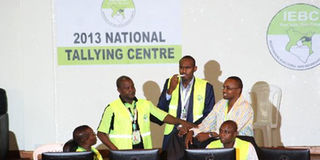Carter Centre concurs with election results, admits IEBC faced challenges

IEBC officials at the Bomas National Elections Tallying centre on March 6, 2013. Photo/PHOEBE OKALL
An American based NGO, the Carter Centre which participated in Kenya's General Election as an observer has concluded that the outcome reflected the will of the people despite challenges the electoral commission faced.
In its report released on Thursday, the Carter Centre said that although the Independent Electoral and Boundaries Commission (IEBC) failed to manage voter tabulation systems correctly, the overall outcome indicated the voting patterns of Kenyans.
“The paper-based procedure for counting and tallying presented enough guarantees to preserve the expression of the will of Kenyan voters,” the report says on the IEBC’s official results as indicated on Forms 34 and 36.
The Carter Centre also congratulated President-elect Uhuru Kenyatta and his deputy William Ruto after the Supreme Court upheld their election victory as announced by IEBC on March 9.
The Centre also praised Prime Minister Raila Odinga, who had petitioned to the Supreme Court to invalidate the results, for accepting the decision of the Court and added that the elections were only a democratic “work in progress” whose mistakes ought to be corrected in future.
The Centre argues IEBC has to learn from this event to regain public confidence in future elections.
They also noted that IEBC was ill-prepared to use the system and even when it conducted trials, they were not fully successful to guarantee a seamless functioning.
“Reliance on technologies that were only partially successful during the mock election exercise threatened to undermine the very trust they were designed to enhance,” the Centre said.
“Some of the problems encountered by IEBC could have been avoided by using simpler, more reliable, and less costly solutions,” added the report.
IEBC was also on the spot for not giving its officers an appropriate alternative in cases where the poll books and other gadgets for voter results transmission failed, and for not giving clear responsibilities to each officer.
For instance, the Centre’s observers charge that there were no operational manual procedures for the national tabulation of votes.
“The absence of detailed procedures did not enable election officials to consistently troubleshoot data entry errors or counting discrepancies,” it added. “These procedures should be published well in advance, shared with all stakeholders, and also address the review and audit of results by election officials to ensure adequate and transparent safeguards are in place.”
However, the observers commend IEBC field agents for working within the time schedule despite the imprecise procedures they received.
The IEBC was commended for publicising regulations and procedures on transmission, receipt and processing of results to stakeholders such as party agents, journalists and election observers as well as allowing full access to tallying centres.
However, the Centre laments that insufficient descriptions of tabulation instructions were shared with Carter Centre observers which “appeared to be insufficient to guarantee the integrity and accuracy of numerical tabulation.”
Mr Odinga who ran on an ODM ticket in the Cord alliance scored 5,340,546 votes or 43.31 per cent of the votes cast against Mr Kenyatta’s 6,173,433 votes (50.07 per cent).
However, Mr Odinga accused the IEBC of declaring a victory based on erroneous voter register and manipulation of figures on Forms 36.
Last Saturday, the Supreme Court dismissed his petition but it is due to publish a full ruling in ten days’ time.
The Centre though argued that the results were determined by “a missive voter turnout” in Mr Kenyatta’s strongholds in Nyandarua, Murang’a, Nyeri and Kiambu counties.




